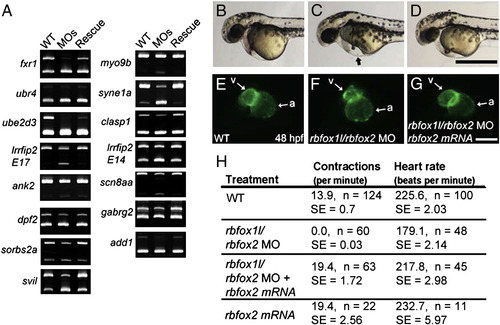Fig. 8
- ID
- ZDB-FIG-111128-41
- Publication
- Gallagher et al., 2011 - Rbfox-regulated alternative splicing is critical for zebrafish cardiac and skeletal muscle functions
- Other Figures
- All Figure Page
- Back to All Figure Page
|
Splicing and physiological defects are rescued with exogenous rbfox2. (A) Splicing analyses of 15 exons that are abnormally spliced upon rbfox1l, rbfox2, or double rbfox1l/rbfox2 knockdown show that normal splicing patterns are restored upon co-injection of MO-resistant rbfox2 mRNA. (B–G) Co-injected rbfox2 mRNA rescued heart-related defects caused by rbfox1l/rbfox2 knockdown. At 48 hpf, rbfox1l/rbfox2 double morphants exhibit pericardial edema (arrow in C, compare to wildtype embryo in B) that was reduced by co-injection with rbfox2 mRNA (D). Ventral views of the same myl7-GFP embryos shown in B–D reveal that ventricle morphology of embryos co-injected with rbfox1l/2 MOs and rbfox2 mRNA (G) are indistinguishable from wild type (E). (H) Functional defects in skeletal muscle and heart in Rbfox double morphants, as measured by muscle contractions at 24 hpf and heart rate at 52 hpf, respectively, are rescued by co-injection of rbfox2 mRNA. WT = mock-injected; MOs = rbfox1l + rbfox2 MO; MO = morpholino; E = exon; a = atrium; v = ventricle; n = number of individuals sampled; SE = standard error. Scale bars = 500 μm (B–D), 100 μm (E–G). |
Reprinted from Developmental Biology, 359(2), Gallagher, T.L., Arribere, J.A., Geurts, P.A., Exner, C.R., McDonald, K.L., Dill, K.K., Marr, H.L., Adkar, S.S., Garnett, A.T., Amacher, S.L., and Conboy, J.G., Rbfox-regulated alternative splicing is critical for zebrafish cardiac and skeletal muscle functions, 251-61, Copyright (2011) with permission from Elsevier. Full text @ Dev. Biol.

